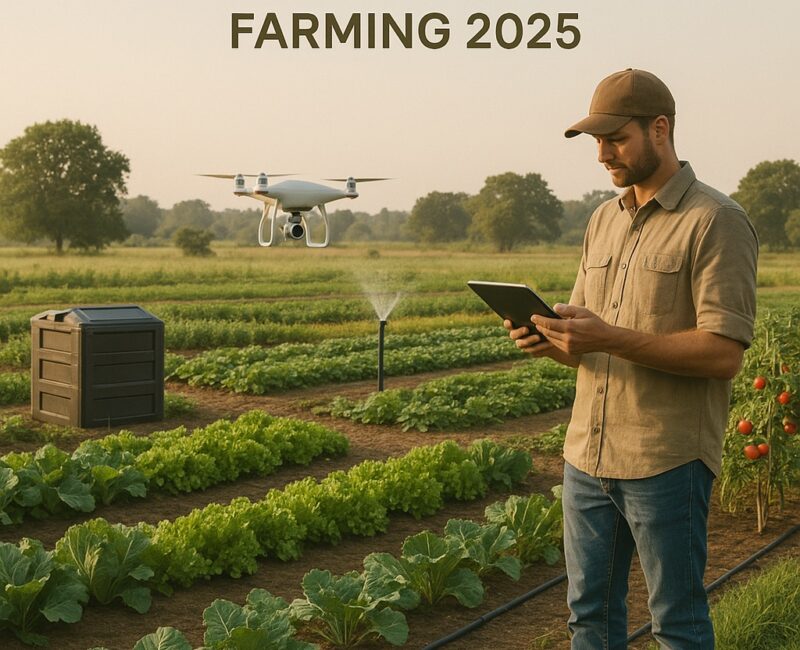Organic farming is no longer just a buzzword — it’s a full-blown movement transforming agriculture globally. As we step into 2025, organic practices are being shaped by tech innovations, changing consumer behavior, climate action, and policy support. Whether you’re a budding agri-preneur in the US or a sustainable farm advocate in Germany, these trends are set to reshape how the world grows food.
In this blog, we explore the most impactful organic farming trends of 2025 across North America, Europe, and beyond.
1. Rise of Regenerative Organic Certification
The demand for clean, nutrient-rich produce has driven farmers to go beyond traditional organic practices. Regenerative Organic Certification (ROC) — which includes soil health, animal welfare, and social fairness — is gaining traction in the US, UK, and EU.
Key Takeaway: Consumers are not just buying organic, they want “soil-to-soul” sustainability.
2. Tech-Powered Organic Farming
From AI-powered pest control to blockchain traceability, organic farming is being supercharged by agri-tech.
- Drones for soil & crop monitoring
- IoT sensors for real-time organic compliance
- Blockchain for transparent supply chains
Hotspot Regions: California, Ontario, Bavaria, and the Netherlands
3. Urban Organic Farming Expansion
With food miles under scrutiny, urban dwellers are turning rooftops, balconies, and brownfields into organic farms. Hydroponic and aquaponic systems are thriving under organic standards in cities like London, New York, Berlin, and Melbourne.
Opportunities:
- Organic rooftop farm kits
- Subscription models for city-grown produce
4. Climate-Resilient Organic Practices
Extreme weather is driving farmers toward native seeds, composting, and biochar. Techniques like intercropping, mulching, and vermicomposting are helping maintain yield without harming the ecosystem.
Examples:
- Drought-resistant organic farms in Spain
- Flood-resilient rice farming in Louisiana
5. Direct-to-Consumer (D2C) Organic Models
Organic CSAs (Community Supported Agriculture), online farm stores, and social commerce are disrupting how organic products reach homes.
Trending Platforms:
- Farmbox Direct (US)
- Riverford (UK)
- CrowdFarming (EU)
Why it works: Builds trust, reduces supply chain emissions, and improves farmer margins.
6. Policy Push: Subsidies & Certifications
Government support is growing:
- EU: Green Deal & Farm to Fork Strategy
- US: Organic Certification Cost Share Program
- Canada: Organic Standards Update 2025
Implication: Lower barriers for small organic businesses and new entrants.
7. Demand Surge for Niche Organic Products
Organic garlic, heirloom tomatoes, ancient grains, and medicinal herbs are becoming high-demand, high-margin crops.
Micro-trend: Wellness-led diets are increasing demand for functional foods like turmeric, ashwagandha, and moringa.
8. Regional Organic Market Growth
US: Fastest-growing organic dairy and baby food sector
- UK: Surge in organic snacks and convenience meals
- Germany: Leading in organic meat alternatives
- Australia: Export-focused organic grains
- Canada & NZ: Rising small organic vineyards
9. Business Opportunities in Organic Farming
- Start an organic herb garden for D2C ecommerce
- Offer organic soil blends or compost kits
- Build digital traceability platforms for organic farms
- Launch farm stays that double as agritourism
10. Challenges in Organic Farming
- Higher labor costs
- Pest control without synthetic chemicals
- Certification complexities
- Crop rotation knowledge gap
Pro Tip: Start small, collaborate with local co-ops, and leverage agri-tech.
Conclusion
2025 is a golden year for organic farming innovation and profitability. Whether you’re looking to invest, start small, or scale sustainably — now is the time to go organic and think global.
Let’s cultivate a future that’s green, clean, and community-powered.





